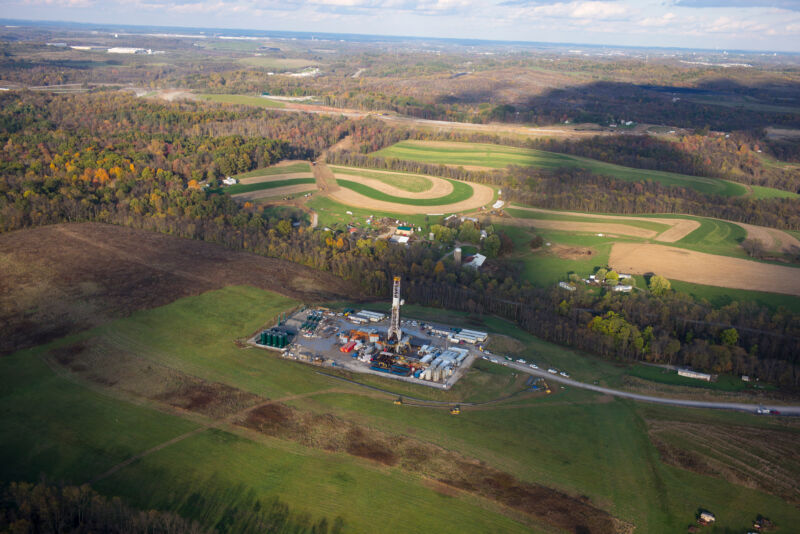
Enlarge / A hydro-fracking drilling pad for oil and gas operates October 26, 2017 in Robinson Township, Pennsylvania.
A fracking drilling pad operates in the Marcellus Shale formation near Robinson Township, Pa. Credit: Robert Nickelsberg/Getty Images
In 2007, a geoscientist at Penn State named Terry Engelder calculated that Pennsylvania could be sitting on more than 50 trillion cubic feet of accessible natural gas deposits. Engelder later revised his calculation upward, to 489 trillion cubic feet, enough to meet U.S. natural gas demand for 18 years. These massive numbers set off the fracking boom in Pennsylvania, leading to drilling across the state. Since the rush began, there have been 13,000 unconventional wells drilled in Pennsylvania.
Now, a new “astounding” calculation has caught the attention of the gas industry: A study from researchers at the National Energy Technology Laboratory shows the wastewater produced by Pennsylvania’s unconventional wells could contain enough lithium to meet 38 to 40 percent of current domestic consumption. Lithium is a critical mineral that’s an “essential component” of many clean energy technologies, including batteries for electric vehicles.
The study used chemical and production compliance data from the Pennsylvania Department of Environmental Protection to estimate that approximately 1,160 metric tons of lithium per year could be extracted from this produced water, which is a combination of fluids used for fracking and water from natural formations underground that returns to the surface during the drilling process. The lithium in Pennsylvania’s produced water likely comes from ancient volcanoes that were erupting at the time the natural gas deposits were being formed. This volcanic ash contained lithium that eventually seeped into the water underground.
“The researcher community in the U.S. is really working hard to find the materials and methods that will enable us to meet our climate goals and decarbonize the economy,” said Justin Mackey, the study’s lead investigator. “Sometimes you might be surprised where that material actually comes from.”
The Marcellus Shale Coalition, an industry trade group dedicated to the Marcellus Shale formation, the natural gas deposit beneath Pennsylvania, West Virginia, Ohio and New York, reacted to the news with enthusiasm. “This scientific analysis by one of the leading energy laboratories in the world shows once again how abundant Pennsylvania natural gas can enhance America’s energy, environmental and national security,” the coalition said in a statement.
The United States currently relies on imports from Argentina, Chile and China to fully meet its lithium needs, and the demand for lithium is expected to rise dramatically as the clean energy transition accelerates.
Mackey, a research geochemist at the National Energy Technology Laboratory, said he had focused on lithium because it is a strategic material for the American economy and defense industries and because it has insecure supply chains. “We’re reliant on foreign entities like China and Chile and Australia to source these raw materials, but they’re critical to our economies,” he said. “And more importantly, they’re critical to decarbonizing the U.S. automotive fleet.”
He said the researchers were “shocked” that the highest concentrations of lithium found in the Marcellus “are comparable to lithium brine, to water that is actually being mined for lithium.”
“I think having more domestic sources of lithium is definitely a positive thing, especially if you don’t have to create a mine to exploit the resource,” Mackey said. Unconventional drilling waste is likely to be produced in large quantities for the foreseeable future, he said, and if remediating this waste safely could also be made economically valuable, that could be beneficial for the environment as well.